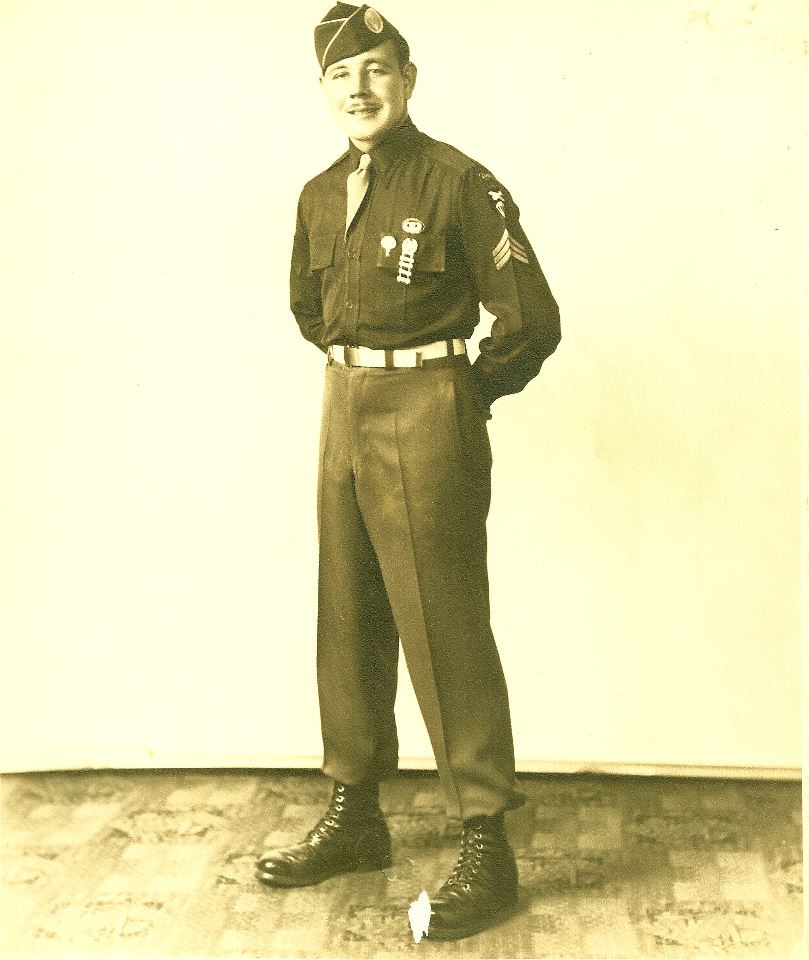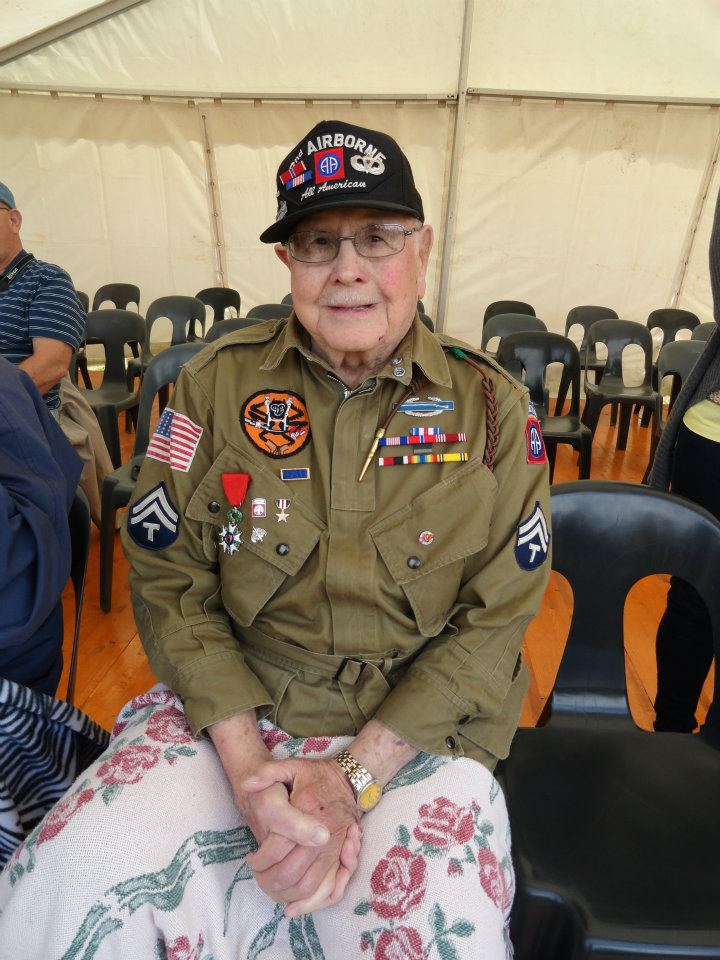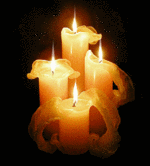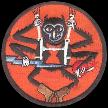
Earl J Geoffrion
|
IN MEMORIAM |
|
It's with great sadness that I must inform you of the death of Earl Geoffrion. He passed away Monday August 12, 2013 from congestive heart failure. We should never forget that this man has done for us. Thank you my friend for all and rest in peace. God Bless you! |
Thank you so much to Earl for agreeing to answer to my numerous questions and to send me some wablink to complete my notes. I hope to meet you in Normandy in 2014 for the 70th Birthday ceremonies...
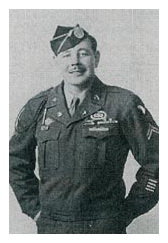 <-
Earl in 1945
and in 2011 ->
<-
Earl in 1945
and in 2011 ->
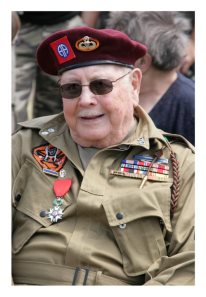
Earl Geoffrion was born in
Toledo, Ohio, April 16, 1918.
"My father, Adolph, remarried after my birth mother died when I was very
young. My parents had 12 children. I was a freshman when my mom died. So I
stopped my studies and worked on a farm in Grand Rapids, Ohio. I was the fourth
youngest. Today, my sister Lucile and I are the last alive. "
Earl grew up during the Great Depression, hard times, but still, Earl had a
happy childhood.
His dad was a foreman for the State Department of Transportation. After
graduation, Earl also joined the Department of Transportation.
"I had many jobs before being engaged in joining railways Toledo where I
worked as an engineer. I drove trains on the route Chicago to Detroit and
Cleveland route until I was drafted shortly after the attack on Pearl Harbor.”
During his civilian life, Earl
was passionate about into boxing. He participated in took part of the Golden
Gloves competition in 1928. Shortly after the Japanese attack on Pearl Harbor on
7 December 1941, Earl Geoffrion was drafted.
"I was sent to Camp Perry near Toledo. Because of my experience, I became
a military engineer. After a month, I was ready to leave for Egypt where I had
to drive conduct trains. Due to my prior experience I was a Tec-5th Grade, which
corresponds to is the same as Corporal.”
But some time before being sent
to Egypt, Earl makes made a decision that will would change his entire military
life.
"I saw an ad where looking asking for volunteers to become a paratrooper
and where there was it mentionned a jump pay. I asked for my transfer. I had
been promoted before that, Sergeant 4th Grade (Tec-4th Grade), but my
engineering commander canceled it because he was angry that I left in for the
paratroopers. I lost my rank of Corporal, but shortly after the jump training, I
renamed became Tec-5th Grade, Corporal. I wore the chevrons of Corporal, I did
not like the word "Tech" too stigmatized. “
Earl was sent to A Company,
507th PIR, with whom he trained paratroopers difficult went through some tough
training.
"Tough, but good training, with good officers. I don’t remember jumps
being different, except for the weather conditions. Remember this was the great
depression generation, many people had never been in an airplane and did not
know what to expect. I flew 13 times before jumping. The first jump was canceled
each time because of the presence of tornadoes. "
During this period in the
United States, an incident that happened. One night, Earl was walking with a
young girl, bringing her home. They passed by a group of F Company paratroopers.
Some of these guys were just looking for a fight. They insulted Earl and his
girlfriend. Earl approached of walked up to the guy and asked him to repeat what
he had said. There was no way to reason with this guy. The fight was inevitable.
Earl, being a Golden Gloves contestant, the fight lasted only a few seconds.
Earl hit the guy on the side of the head. The End. The other guys in F Company
did not care to interfere when they saw the powers of the former boxer.
But a few days later, Earl was arrested and sent to a military prison at Fort
Leavenworth for 90 days. The paratroopers are trained to fight, and the blow had
been fatal to the guy in F Company .
After 90 days, Earl joined his regiment, but was transferred to another company.
He was sent to the Service Company where he became a Parachute Rigger.
On the 23rd of
November 1943, the 507th PIR was transferred to Camp Shanks and Fort Hanilton,
New York before embarking on HMS Strathnaver and the Libertyship Susan B Anthony
direction heading for Northern Ireland it reached where it docked in December.
The regiment was attached to the 82nd Airborne Division.
During this period in Ireland and then in England, training resumed with many
jumps.
"I was in the Service Company, a Parachute Rigger, but they wanted
volunteers to jump into Normandy and serve as bodyguard to the regimental
command post. I was a volunteered and I was finally selected. We were supposed
to protect the Colonel George V Millet. “
The mission also includes the demolition of rail and road communication lines,
Earl followed attended two weeks of training with demolition charges and firing
the bazooka.
"We did have
contact with civilians there. I often worked chute patrol there as a type of MP
of paratroopers.”
From 28 May 1944, the men were held incommunicado in assembly
areas. D-Day approaching. Finally at twilight on June 5, paratroopers climbed
into the C-47.
At 2:30 am, June 6, 1944, the first parachutes domes were deployed into over
Normandy.
Earl and several of his friends were given tasks such as defending the PC of the
507th PIR.
"Colonel Millet didn’t jump
near us. I think he was in the third plane and I was in the first. The Colonel
was captured on the third day. '
"I landed in about 2 feet of water. The first guy I saw was General Gavin, the
82nd Airborne Airborne Division Assistant, he was about fifteen feet
from me. From that moment on, I accompanied the men of the 508th PIR, where I
carried out missions of destruction. "
During one of his missions, he was accompanied by a paratrooper with of the 508th PIR of what and they destroyed a railroad.
One of the objectives of the Earl’s division was taken to take the bridge over the Merderet and the La Fiere causeway. The bridge had already been secured by paratroopers from Company A of the 505th PIR ; they suffered several German counter attacks (see biography Robert "Bob" Murphy-505th PIR).
But on the evening of 7 June, it was imperative to push the
Germans towards Cauquigny and establish a bridgehead across the Merderet. Earl
was a member of the Company of Captain Bob Rae’s company. Earl spent the early
hours of June 8, 1944 in a foxhole near the La Fiere causeway. At about 3am, he
was attracted awaken by a voice calling for help ; it was a wounded soldier
located lying somewhere on the other side of the Merderet. Earl party found his
commander, 1st Lieutenant Rufus Broadway, saying he wanted to go and see what it
was. Together, they went to the front line, asking the soldiers not to shoot.
Keeping only his pants on, Earl entered the cold water covered with a light
brown. He did not see the injured man and was especially concerned about the
presence of the moon. It offered a perfect target for a German sniper. After
swimming a few yards, he came upon three injured paratroopers. They needed
immediate medical attention. Earl took a man on his back and swam towards his
lines and the medics waiting on the shore. He left them take care of the wounded
and the medics said there were two other guys who needed help. Sergeant Nash,
who was also present offered his services. A two they both returned to the
wounded and brought them back alive.
For their bravery, while the two men were recommended by the Lieutenant Broadway
to be awarded the Soldier ‘s Medal.
The quote citation is signed by Major General Ridgway and Lieutenant Colonel
Gordon K Smith:
Earl J
Geoffrion, 35283820,
Technicien Fifth Grade, 507th Parachute Infantry, for
extraordinary heroism not involving actual combat with the enemy on 8 June 1944
in the vicinity of La Fiere, France. Learning that two wounded soldiers on the
opposite bank of Merderet River were badly in need of emergency first aid
treatment, Technician Fifth Grade Geoffrion, without though of the personal
danger involved, waded through heavy swamps and swam the deep channel of the
river to reach his comrades. The prompt administering of this first aid probably
saved the lives of the two wounded soldiers. Technician Fifth Grade Geoffrion’s
unselfish and heroic action are worthy of emulation.
The next day, June 9, 1944, General Gavin ordered an attack on the other side of the river Merderet through the single bridge and La Fiere causeway in the direction of Cauquigny.
The 325th GIR led the attack,
but the assault became bogged down and stopped after numerous heavy losses.
The 507th PIR was ordered to cross the lines of the 325th GIR and resume the
assault on the roadway in the direction of Cauquigny. Earl was waiting with
several other soldiers behind a wall between the house and the barn, the signal
for the assault. He would be the first to jump.
"We had to jump over the wounded and avoid walking on the dead scattered
on the small winding road. Some men managed to crawl to the side of the roadway
plunged into the flooded fields on both sides of the road. “
The men were greeted by gunfire from German weapons : small arms, grenades,
machine guns and artillery. The road was littered with wrecked vehicles, bodies,
wounded and those who were frozen struck by fear, chaos. Earl had the courage to
run from one to the other, to urge them to get up and keep moving forward and in
defiance of ignoring enemy fire.
"After crossing the causeway, I remembered that a bullet hit my weapon
broke throwing me in a foxhole on top of a dead German. Fragments touched hit me
on the knee. Having no weapon, I took the MP40 of the German dead and I
continued the attack. However, the gun had a distinctive sound. And fear of
being picked as an enemy, I letit go. Another GI gave me a gun and I could
continue to attack. The Germans had dug their positions in a cemetery. I shot a
German officer who left his foxhole. Everything happened very quickly. "
Many years later, Earl learned that
he had been recommended by his
platoon leader, 1st Lieutenant
Rufus Broadway
to be awarded the
Silver Star.
But the papers were lost.
Finally, 24 February 2012, 67
years later, the error was
corrected, and
Earl Geoffrion
was awarded the Silver Star.
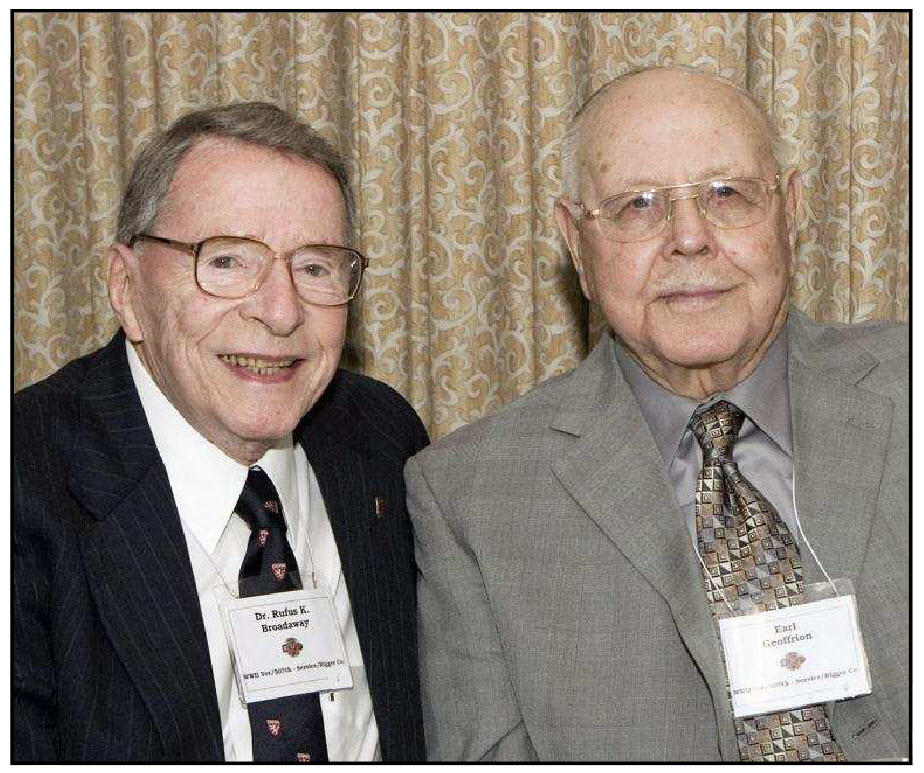
1st Lieutnant Rufus Broadway with Earl Geoffrion
The fighting took
place went on until the
capture of the village of Le
Motey. The bridgehead was
established successfully. July
10, Earl was sent to the Aid
station. A doctor examined
checked his knee and had
his ankle bandaged.
Because of his injury
and reduced limited mobility,
he was assigned to a unit involved in
graves registration.
"We had to pick up all the dead soldiers first and then placed in a wood. I looked at everyone because I wanted to see if he was one of my friends. It was terrible. The worst thing I had to do was to take care of 12 soldiers who drowned. “
He remained in this unit about
two weeks. Each paratrooper was wrapped in his chute before being buried. German
soldiers were buried, but later. They were not a priority.
On 12 July 1944, the 507th PIR left Normandy and returned to England. The
regiment fought 36 days and suffered 938 casualties, killed, wounded and
missing.
Back in England, Earl and Sergeant Nash received their Soldiers Medal from the
hands of General Howell.
"We were lined up when we resumed decoration to receive our medal. Then,
we were positioned in front of the tribune stand and the entire 82nd Division in
its entirety paraded before us, greeting us."
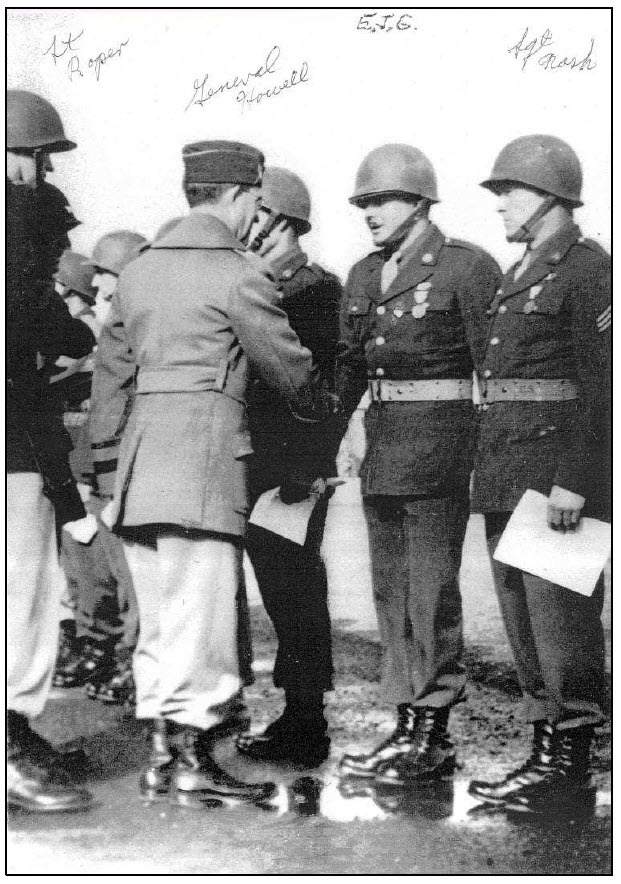
Earl Geoffrion shakes hands with General Howell on the day of delivery of the medal.
Some time
later, the regiment was assigned to the new 17th Airborne Division to the damns
of with great anger from the veterans who did not want to leave the 82nd
Airborne veterans of Normandy.
"We were all very disappointed. We thoughtwe would remain permanently with the 82nd Airborne. '
During this period, the men
continued to train, and made several jumps. As before Normandy, Earl served as
"MP Parachute" to get pick up the soldiers after the jump.
Since November 1944, Montgomery had made plans for an airborne operation in
January 1945 on the other side of the Rhine. To do this, the Earl ‘s Rigger
Company was sent to France, north of Paris to prepare for the operation.
But on 16 December 1944, the Germans upset Montgomery’s project.
Earl is still in France, while the 17th Airborne Division is at the front. When
they need reinforcements, Earl and his comrades climbed into the truck and roll
hastily towards the Bastogne area.
Later, when the division is stationed along the border between Luxembourg and
Germany, Earl and his comrades are again sent back to France in preparation for
Operation Varsity.
Earl prepared the chutes of his comrades and various security issues, but he did
not jumped in Germany. He rejoined his unit in Germany after the jump. Earl
travelled through Germany and saw the latest fighting in Duisburg.
At the end of the war, the 17th Airborne Troop occupation area was in the region
of Essen. The 507th PIR occupied the city.
Then, the division was chosen to be the “division points higher”. The men were
sent to different units while Airborne veterans from other units who had enough
points to be discharged, were sent to the 17th Airborne.
Earl was sent to the 101st Airborne Division who had to leave to fight in the
Pacific. The two atomic bombs ended the war.
Earl left Europe October 11, 1945 and arrived in the United States on November
11, 1945 and was discharged November 15, 1945.
On his return home, Earl returned to work in the railway company where he
retired at the age of 67 years. He married Matilda a 100% Italian woman.
They had a daughter. Today, they have 3 grandchildren and 2 great son
grandchildren.
Earl now lives peacefully in Oregon, Ohio. He loves to fish and play golf for 70
years. He also plays NASDAQ.
Since the end of the war, Earl revenues in Europe, many times. "But I had
to wait 50 years before returning in Europe.”
Finally, as a last gratitude for his service in Europe, in April 16,
2007, Earl Geoffrion was awarded the French Legion d'Honneur.
